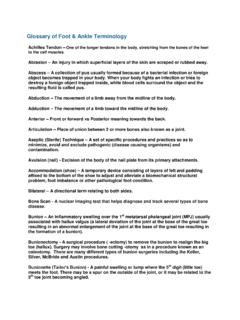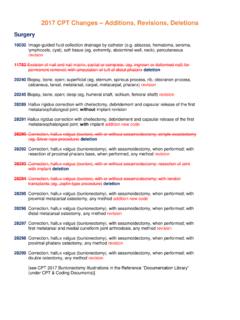Transcription of The Nigeria national blindness and visual impairment survey
1 The Nigeria national blindness and visual impairment survey 2005-2007. The Nigeria national blindness and visual impairment survey 2005-2007. Executive Summary Overview CI: to ) at 40-49 years to (95% CI: The national blindness and visual impairment to ) among those aged 80 years (p =. survey in Nigeria was conducted in 2005-2007 < ). (30 months of field work) Females had a higher prevalence of blindness than males ( vs )( p =< ). Multi-stage stratified cluster random sampling, with probability proportional-to-size procedures, was Illiterate participants had far higher prevalence of used to select a cross-sectional, nationally blindness than those who could read and write representative sample of the population ( vs )(p = < ). A total of 13,599 persons aged 40+ were examined The South West GPZ had the lowest prevalence of across the country (response rate ).
2 blindness ( ; 95% CI: to ) and the North East GPZ had the highest ( ; 95% CI: Prevalence of blindness and visual to ) (p = < ). impairment The prevalence of blindness and SVI did not differ The prevalence of blindness in the sample using by urban/rural place of residence (p= ). presenting vision (PVA) of <3/60 in the better eye was (95% CI: to ) and the prevalence In multivariate analysis, age, gender, GPZ and of severe visual impairment (SVI) was (95 % literacy remained significantly associated with CI: to ). Using best corrected vision (BCVA) blindness after adjusting for age and gender in the better eye, (95% CI: to ) were differences blind, (95% CI: to ) had SVI, It is estimated that 1,130,000 individuals aged Front cover (95% CI: to ) had moderate visual 40 years are currently blind in Nigeria (95% CI: Participant impairment , (95% CI: to ) had mild million).
3 The North West geo-political having his visual impairment while 86% (95% CI: to zone (GPZ) has the largest number of blind adults distance visual ) were categorized as normal/near normal. ( ) being the zone with the largest population. acuity measured A further 2,700,000 adults aged 40 years are using a reduced Associations of blindness and visual estimated to have moderate visual impairment and logMAR visual impairment with socio-demographic an additional 400,000 adults are severely visually acuity chart factors impaired. Thus a total of million adults aged . Below survey The prevalence of blindness among those aged 40 years in Nigeria are visually impaired or blind. participants in 50 years was (476/8702) and South West The prevalence of blindness varied across the (476/5125) among those aged 60 years different ecological zones being highest in the sahel geopolitical zone (PVA <3/60 in the better eye) ( ) and the lowest in the delta ( ).
4 Waiting to be examined by the The prevalence of blindness (PVA) increases The prevalence of blindness in people of all ages survey team significantly with increasing age, from (95% was estimated to be 2. Causes of blindness and visual impairment Contents Cataract was the commonest cause of severe visual impairment and blindness being responsible for and respectively. The prevalence of Executive summary 2. cataract blindness was (95% CI: ). Glaucoma was the second commonest cause of Collaborating institutions 4. blindness ( ) (prevalence ; 95% CI: ) survey teams 5. Corneal scarring from all causes was responsible for of blindness Acknowledgements 7. 84% of blindness was due to avoidable causes Introduction 6. Uncorrected refractive errors were the commonest cause of mild and moderate VI ( and Purpose of the survey 6.))
5 Respectively) being responsible for visual impairment in million adults in Nigeria ( acuity of Specific objectives 6. <6/12-6/60). Background 6. Operable cataract ( visual acuity of <6/60). affects 400,000 people and glaucoma has caused blindness in a further 150,000 adults Methodology 7. By the year 2020 the number of adults with operable survey data collection 8. cataract will increase by 43% to 600,000 assuming that the incidence of SVI and blindness due to cataract and cataract surgical coverage remain Results 11. essentially unchanged over the next 12 years. Adult population surveyed 11. Cataract surgery and surgical outcomes Ecological zones and blindness 15. Among all operated eyes, had been couched Causes of blindness and visual impairment 16. (traditional procedure for cataract). Among cataract operated eyes had not had an Adjusted association analyses 18.
6 IOL implanted Number of people with visual loss by cause visual outcomes after cataract surgery were poor with in 2008 and 2020 19. having a PVA of <6/60. After correction, nearly 50% with a poor outcome Causes of blindness in ecological zones 20. improved to 6/60 or better. Cataract surgical outcomes 20. Other findings Hypertension Stage 2 occurred in of Couching 22. participants ( systolic blood pressure (BP) of 160 mmHg and diastolic BP of 100mmHg) being Cataract surgical coverage 22. more common in females than males and in older than younger participants Children examined 24. Hypertension Stage 3 occurred in ( systolic BP of 180 mmHg and diastolic BP of 110mmHg) Prevalence of hypertension, obesity which again was more common in females and which increased with increasing age and diabetes, poor water supplies A body mass index of 25 affected over a quarter of and sanitation 24.
7 Participants, being more common in females than males ( vs ) Dissemination of the findings 26. Water supplies were unprotected in almost two thirds of households included in the survey ( their water Publications 26. came from an open well or from ponds or streams). Capacity building 26. Diabetes was diagnosed in of participants in the normative database ( one in every eight participants;. diagnosis was by random blood glucose). 85% were References 27. unaware that they had the condition. 3. The Nigeria national blindness and visual impairment survey 2005-2007. Above survey team members checking a Collaborating institutions data entry form Institution Principal responsibilities International Centre for Eye Health Technical guidance for the survey design, London School of Hygiene and Tropical Medicine, provision of training, external supervision of Keppel Street, London WC1E 7HT, UK the survey activities, data analysis and report writing.
8 Institute of Ophthalmology Setting up equipment for the survey , and Bath Street, London, UK training survey teams in packing, unpacking and transporting equipment; care of equipment, maintenance and simple repairs. national Programme for the Prevention of Government institution responsible for the blindness (NPPB) co-coordination planning and implementation Federal Ministry of Health of eye care programmes in Nigeria . Primarily Abuja, Nigeria involved at the level of the NPPB Zonal Co-ordination offices during the survey . national Eye Centre Government tertiary specialist eye hospital Off Nnamdi Azikiwe By-Pass, 2267, which was the centre for training survey Kaduna, Nigeria teams. Sightsavers International Assisted in recruitment of survey teams, and Nigeria Country Office provided training and support to Resource Kaduna, Nigeria Manager, particularly with respect to managing the budget.
9 Sightsavers International International non-government development Grosvenor Hall, Bolnore Road, Haywards Heath, agency specialising in supporting blindness West Sussex RH16 4BX, UK prevention programmes in developing countries, including Nigeria . 4. survey teams Co-ordinator Mansur Rabiu Other Core Team Members Ophthalmologists: Abdull M Mahdi, Fatima Kyari, Tafida Abubakar, Abdullahi U Imam, Optometrists: Christian Ezelum, Gabriel Entekume Finance Manager: Mrs Oye Quaye Data Entry Team: Mr. Auwal Shehu, Mr Charles Dania North East North West North Central South East/ South West South South Musa Ishaya Kabir Mailfia Adedoyin Y Modupe Fasakin Late Henry Pero Late Martha E . Abdulrahman S. Mercy O. Okorie Ogunjimi Hussaini Hong Mamman Mohammed Victoria Ginikanwa Olatunji Sidi Sheriff Bello Buhari Rebecca K.
10 Hunduh Felicia Alabi Fati Bukar Abba Opawoye O. Chianakwalam Fatima Ibrahim Akomolafe Gana Oluwatoyin Atim E. Okpo Aisha Salihu O. Animasaun Hadiza Haruna Magaji Kuku Ifepe Dahiru Mohd Adewale Ibrahim Moses Martin Martha Ukeh Margeret Musa Abodunrin Dubai Muhd Yusuf Musa Otomere Musa Benjamin Lamidi Zainab Mahmud Yunusa Zarumai Apiphen Baba Saleh Bukar Mary O. Egwu T. Abdul Razaq Abdullahi Haro Yilleng Titus Wiliam Madu H Tilla Florence Orukpe A. Adeleke Suleiman D Ibrahim Abiodun F. Comfort Ashiru Galadima Edwin Okolo Opasina Abubakar Kadi Abdulfatai K. Aisha Hasan Mato Gilbert Daminagbo Akinola Murtala Haruna Babatunde Sariga M Ibrahim Casmir OOnwukwe Adijai Mamuda Umar Mohd Idris Larry Yusuf Yammai Kukashenka John Undie Adetola Rabiu Mohd Sani Farouk Sirajo Zubairu I Babakolo Ugoo Abba Hassan Yusuf Kaura Christiana Adamu Hilary Adie Isa Abdulkadir 40 other personnel assisted in the survey : the cooks, drivers and ophthalmic nurses Acknowledgements The national survey of blindness and visual impairment is the (West Africa office).








